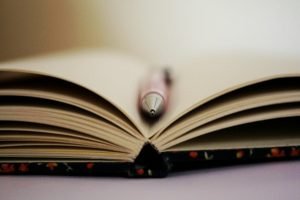Thank you to Trudy Hale and the Streetlight Magazine editors for choosing me to be your new poetry editor. I’m excited and grateful to be part of this ever developing and stimulating home for “exceptional talent, both new and established.” As I begin reviewing the poetry submissions we receive, I see several which come very close, but are not quite ready for publication. I can’t help but imagine that poets and writers and readers of Streetlight Magazine are wondering, “Who is she?” and “What is she looking for in my poems?”
Poetry in which the voice of a speaker is clear and present, and in which clear sensory images can easily be perceived by readers are always appreciated. The Next Story, a four stanza poem by Pattiann Rogers from her book, Splitting and Binding, published 1959 by Wesleyan University Press, is such a poem.
All morning long
they kept coming back, the jays,
five of them, blue-grey, purple-banded
strident, disruptive. They screamed
with their whole bodies from the branches
of the pine, tipped forward, heads
toward earth, and swept across the lawn
into the oleanders, dipping low
as they flew over the half-skull
and beak, the blood-end of the one wing
lying intact, over the fluff
of feathers scattered and drifting
occasionally, easily as dandelion—
all that the cat had left.
The speaker immediately shows in the tone of her voice that she is emotionally affected by the scene outside. And her tone of voice is created and revealed with careful word choices and phrasing. An astute use of line breaks recreates the tension of the situation throughout.
This poem is four stanzas long, filled with energy, and well worth several reads. A poem with energy, a poem that comes alive and pulls the reader into its irresistible world, will catch an editor’s attention over those which offer flat detail telling of something that happened, and finished with an a line of “wisdom” at the end.
In stanza two, Rogers begins to move away from what really happened, toward a universal feeling that humans can relate to:
…The pattern of their inconsolable
fear can be seen against the flat
spring sky as identical to the pattern
made by that unmendable shatter
of disjointed rubbish on the lawn,
all morning long.

The poet’s job is to craft the piece so that what happened matters to the reader as well as the poet. In a published poem, which is an offering to an audience, the “what happened” must go beyond personal experience. In the best poems, what “really happened” becomes irrelevant except as a springboard for the poet to choose a topic and get the poem going. There is no need to stay true, throughout the poem, to the reality of the original situation.
Pattiann Rogers begins the third stanza of The Next Story with a direct address to the audience:
Mothers, fathers, our kind, tell me again
that death doesn’t matter. Tell me
it’s just a limitation of vision, a fold
of landscape, a deep flax-and poppy-filled
gully hidden on the hill, a pleat
in our perception, a somersault of existence,
natural, even beneficent, even a gift,
the only key to the red-lacquered door
at the end of the hall, “water
within water,” those old stories.
In addressing “…our kind,” the poem becomes universal as Rogers reaches toward all people trying to comprehend that everlasting question of what death is and what follows it. Suddenly, what began as a tragedy among birds has become an intimate human issue that begs exploration.
In the final stanza, the speaker declares that the grief demonstrated by the jays is as profound as any she can imagine or has heard expressed by her own species. Repeating, “all morning long” for the third time as the last line weaves the poem together and frames it in a final resonance, the kind that makes an editor want to accept the poem and publish it in every issue of the magazine for the next five years.
But this time, whatever is said,
when it’s said, will have to be more
reverent and more rude, more absolute,
more convincing than these five jays
who have become the five wheeling spokes
and stays of perfect lament, who, without knowing
anything, have accurately matched the black
beaks and spread shoulders of their bodies
to all the shrill, bird-shaped histories
of their grief will have to be demanding enough,
subtle enough, shocking enough, sovereign
enough, right enough to rouse me, to move me
from this window where I have pressed
my forehead hard against the unyielding pane,
unyielding all morning long.
I look forward to reading your submissions.

Featured image: Revision In Process by Julie Jordan Scott. CC license.*
Follow us!Share this post with your friends.


Wonderful introduction, Rose, of this poem and of yourself! Best of luck in the new job!